Iram mehraj* and C. N. Latha
Department of Biotechnology, Vydehi Institute of Biotechnology, Bangalore (India).
Abstract
All the nutrient agar cultures were incubated for the growth of microorganisms exposed for different periods of time. The degree of growth in tabular form was recorded. The killing efficiency of UV rays to the time of exposure of the various microbes and the effect of UV rays when they pass through glass was tested.Unlike higher animals, bacteria do not have a nucleus bacteria DNA is free floating. UV light will not penetrate very far into the bacteria so the exposure must last long enough for the bacteria to turn, and DNA to move close to the surface, for the UV light to destroy the DNA.
Keywords
Bacillus cereus; Staphylococcus auerus; UV light
Download this article as:| Copy the following to cite this article: Mehraj I, Latha C. N. Effect of UV rays (265nm) to Determine the Minimum Amount of Exposure Required to Effect a 100% Kill of the Organism. Bacillus Cereus, an Endospore-Former, and Staphylococcus Aureus, a Non-Endospore-Former will be used to Provide a Comparison of the Related Resistances of Vegetative and Spore Types. Biomed Pharmacol J 2010;3(2) |
| Copy the following to cite this URL: Pareek A, Joseph P. E, Seth D. S. Synthesis, Spectral Evaluation and Antimicrobial Screening of some N1- substituted-3-methyl- pyrazol-5-ones by 2 ways: A Comparative Study. Biomed Pharmacol J 2010;3(2). Available from: http://biomedpharmajournal.org/?p=1643 |
Introduction
UV light is electromagnetic waves with a wave length between 10 and 400 nanometers. These wavelengths are shorter than visible light and longer than X-rays. The name comes from the fact that they are just beyond violet light, the shortest wavelengths that humans can see.Ultraviolet light produces a lethal effect in cells exposed to wavelengths in the range of 210 nm to 300 nm, 265 nm being the most lethal. It induces pyrmidine dimers in the DNA that results in the distortion of the DNA molecule and which interferes in the replication and transcription of DNA molecule during protein synthesis and cause mutation. The effect of radiation is influenced by many variables, e.g. the cell age, composition of media, temperature, and distance and to the time of exposure.
Material and Methods
Cultures of Bacillus cereus, Staphylococcus aureus, Nutrient Agar.
Nutrient agar media was prepared and poured onto petridish. 28 plates of Nutrient agar were made among which 7 Petri plates were labeled with the time of exposure to UV as 0,5,10,15,20,25 and 30 minutes in 4 replicates. Among them 2 set of replicates were inoculated with Bacillus cereus. 1 set (0, 5,10,15,20,25 and 30 minutes) of plate was kept as contro l(with cover lids on ) and other set was treated with UV light (265nm) with cover lid off according to the time schedule 0,5,10,15,20,25 and 30 minutes.
Similarly rest two plates of nutrient agar plates (7*2) were inoculated with Staphylococcus aureus and followed with the above mentioned procedure. Once the inoculation is done all the inoculated plates (both with lid & without lid) were incubated for the microbial growth. After inoculation was done, the plates were properly sterilized and kept for incubation at properly sterilized place. The bacterial inoculated tubes were incubated for 24-48 hours at 35°C . Once the incubation period is over, the microbial growth was recorded.
Results
Lethal effect of ultraviolet radiations (UV rays).
From the above results we can infer that ultraviolet rays have a lethal effect on the microorganisms. As the time of exposure increases the number of microorganism that survive keep on decreasing and at the end of 30 minutes the number of microorganisms that survive is nil. This means with an exposure of 30 minutes 100% organisms are killed.
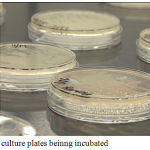 |
Figure 1: culture plates beinng incubated.
|
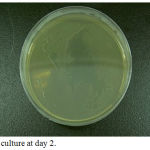 |
Figure 2: culture at day 2.
|
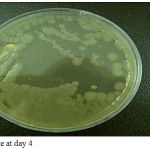 |
Figure 3: culture plate at day 4.
|
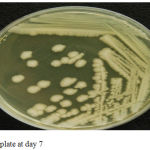 |
Figure 4: culture plate at day 7.
|
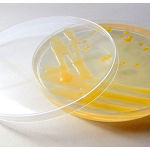 |
Figure 5: Staphylococcus aureus.
|
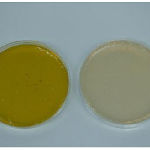 |
Figure 6:
|
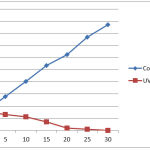 |
Figure 7:
|
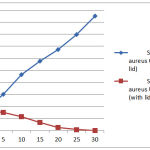 |
Figure 8:
|
Disscusion
Ultraviolet light kills bacteria. Evolution never had a real chance to design bacteria that could function in the presence of UV light, It may take a high dose or a lengthy exposure, but UV light will eventually kill bacteria by scrambling its DNA. Zelle and Hollaender (1955) summarized data from several sources which showed that spores of aerobic bacilli are usually about twice as resistant to killing by ultraviolet light as are vegetative cells of the same species. Study (1956) showed that spores of Bacillus cereus are manytimes more resistant than their vegetative cells.In seeking an explanation for the discrepancies in these data, we noticed that almost without exception data comparing radiation resistance of spores and their vegetative cells were published prior to the report by Kelner (1949). Furthermore,in many of the reports, the vegetative cellsand spores were irradiated on the surface of a nutrient medium. Spores rapidly lose their resistance to ultraviolet light when placed in an environment suitable for germination (Mefferdand Wyss, 1951; Stuy, 1956).
Observation and Result
Lethal effect of ultraviolet radiations (UV rays)
The above protocol was followed and the following results were obtained.
Table 1:
| Time of exposure in minutes |
Bacillus cereus
|
Staphylococcus aureus |
||
| Control
(with lid) |
UV treated | Control
(with lid) |
UV treated | |
| 0 | 78 | 77 | 84 | 83 |
| 5 | 140 | 65 | 150 | 75 |
| 10 | 202 | 56 | 232 | 58 |
| 15 | 268 | 35 | 288 | 33 |
| 20 | 313 | 10 | 336 | 13 |
| 25 | 385 | 5 | 398 | 4 |
| 30 | 435 | 0 | 476 | 0 |
Conclusion
It was evident from the present study that UV radiations might affect the microorganisms up to significant level. Thus, the UV radiations can be used to control the required microbes.
UV radiations caused high reduction in viable count of bacteria with increase in exposure time.
References
- Zhou, H.; Smith, D.W. “Advanced technologies in water and wastewater treatment”. J. Environ. Eng. Sc.,1, 247-264, (2002).
- Durbeej, B.; Eriksson, L.A. “Reaction mechanism of thymine dimer formation in DNA induced by UV light”.J. Photochem. Photobiol. A. Chemistry., 152, 95-101, (2002).
- Irradiation of spores of Bacillus cereus and Bacillus subtilis with electron beams, Jorge De Lara, Pablo S. Fernández, Paula M. Periago and Alfredo Palop, Departamento de Ingeniería de Alimentos y del Equipamiento Agrícola, P° Alfonso XIII, 48 30203, Cartagena (Murcia), Spain, 3 October 2002.
- Comparative Sensitivity to UV-B Radiation of Two Bacillus Subspecies and Other Bacillus Mark Myasnik, Robert Manasherob, Eitan Ben-Dov, Arieh Zaritsky, Yoel Margalith, Received: 13 December 2000/Accepted: 19 January 2001
- J Microbiol Methods. 1999 Feb;35(1):13-21.Method for purification of bacterial endospores from soils: UV resistance of natural Sonoran desert soil populations of Bacillus spp. with reference to B. subtilis strain 168.







